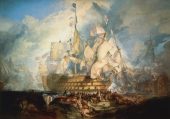
The resurgence of the Arts and Crafts Movement and the designs by William Morris during the late Victorian period saw an interest re emerge in tapestry and their designs. With most of the European workshops in decline following the French Revolution and an increasing awareness of the craft a British Tapestry House was established in 1876 by two Frenchmen, Marcel Brignolas and Henri C. J. Henry. Royal Windsor was one of two tapestry houses to be established in nineteenth century England, the other was William Morris’s Merton Abbey.
French Influence at the Royal Court
Many of the workers in the Royal Windsor Tapestry Works originated from France and the Aubusson Works. Typically the women worked as tapestry repairers and children attended a local public school near the dyeing centre. Brignolas used the Aubusson influence in dyeing and colour schemes; however the exquisite and detailed work produced is probably the finest legacy of this French community. The first piece produced was a bust of Queen Victoria taken from the painting by Baron Heinrich von Angeli and adapted by Phoebus Levin. The youngest son of the Queen, Prince Leopold took a special interest in the factory and the designs, from whom it enjoyed significant royal patronage. The prince chaired the committee formed to oversee the factory and was joined by several other members of the royal family until his sudden death in 1884.
The Royal Windsor Tapestry Works are known for some very detailed and magnificent designs during their short lifetime. These include the famous Merry Wives of Windsor; a series of eight award winning panels which in 1878 won gold medal in Paris. Telling the story of Falstaff these delicate but vibrant masterpieces possess an exquisite detail and are framed with an eye catching border, very much in the French style and exuding cheerfulness and warmth to reflect the play. Flowers found in Elizabethan gardens such as eglantine decorate the panels and add to the detail in the picture itself. These tapestries disappeared for many years, emerging during the late 1970’s when seven panels appeared at auction.
As the Royal Windsor Tapestry Works grew in popularity Queen Victoria took an interest in the designs and encouraged other royals to commission pieces. The initial two low warp looms grew to a total of eight as the work grew in popularity and more commissions requested, with 16 in place at its closure in 1890. The Queen had several tapestry repairs completed at the factory including those from Hollywood.
Shakespeare in Tapestry
Another famous design emerging from Royal Windsor and commissioned by prices Louis, Marchioness of Lorne was a tapestry celebrating, “Much Ado About Nothing. “ It is thought this is the piece that now hangs in Buckingham Palace. The Queen’s Sofa which has two cartoons of detailed and delicate wild roses worked into the design and Queen Victoria’s monogram is a well known Royal Windsor piece and is now part of the Royal Collection. The artists have created a unique collection which captures the British tradition and culture entwined with nature and with a French based design. Significantly these tapestries were designed for royalty and the wealthy and were not mass produced for the emerging middle classes. E. A. Ward designed many of the pieces to come out of Royal Windsor, including its largest tapestry, the Battle of Aylesford. It is believed that very few of the original designs and cartoons have survived. The pieces designed for the Mansion House in London were destroyed during the Blitz, whilst others are thought to have been disposed of by Edward VII in executing the estate of Queen Victoria.
Emerging Trends and the Future
The sudden death of Prince Leopold in 1884 spelled out demise for Royal Windsor and the factory began to decline after a short lifespan producing highly detailed and unique designs. Events coincided with a slump in the general economy and growing nationalism in Europe, and further commissions could not be found. Rather than associate royalty with a bankrupt factory the decision was taken to close the works in 1890. Tapestries were growing in America with the new immigrants wishing to replicate a piece of their European heritage. Many of the French workers including the Foussadier family left England for America taking with the Aubusson way of working into an emerging new market and developing their expertise in the new world. Detailed tapestries remain popular today and with new manufacturing techniques, a well made and detailed tapestry is an affordable and popular way of decorating a home.




































